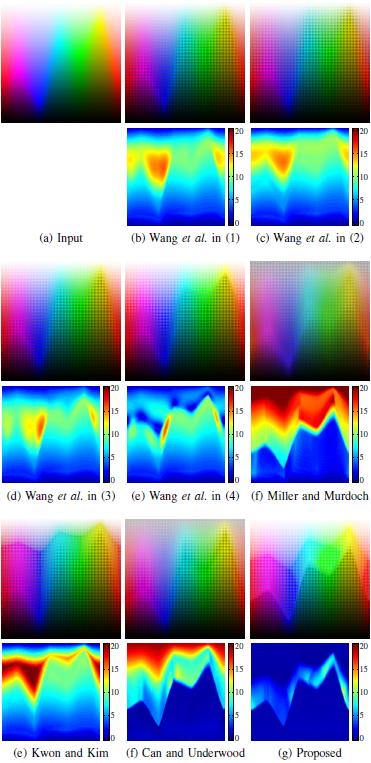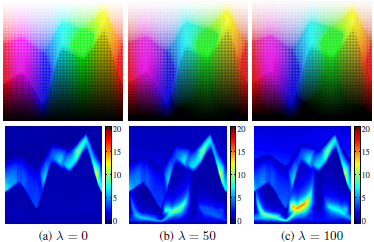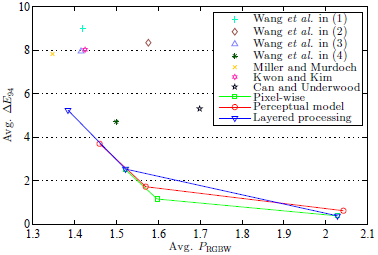Power-Constrained RGB-to-RGBW Conversion for Emissive Displays
Abstract
We propose an optimization-based power-constrained RGB-to-RGBW conversion algorithm for emissive RGBW displays. We measure the perceived color distortion using a color difference model in a perceptually uniform color space, and compute the power consumption for displaying an RGBW pixel on an emissive display. The central contribution of this work is to formulate the optimization problem to minimize the color distortion subject to a constraint on the power consumption. Subsequently, we solve the optimization problem efficiently to convert an image in real time. Furthermore, based on the properties of the human visual system (HVS), we extend the proposed algorithm to image-dependent conversion that can preserve spatial detail in an input image. Simulation results show that the proposed algorithm provides significantly less color distortion than the conventional methods while providing a graceful trade-off with the amount of power consumed. Specifically, it is shown that the power consumption can be reduced by up to 20%, while providing about 50% less color distortion than conventional algorithms. In addition, a subjective evaluation on a real RGBW display is performed which reveals the merits of the proposed image-dependent conversion for improving the perceptual quality over state-of-the-art techniques.
|
|
Example subpixel structures of the (a) RGB and (b) RGBW displays.
Experimental Results
 |
Fig. 1. RGB-to-RGBW conversion results on the sRGB test image. The input RGB image in (a) is converted by Wang et al.'s algorithms [1] in (b)~(e), Miller and Murdoch's algorithm [2] in (f), Kwon and Kim's algorithm [3] in (e), Can and Underwood's algorithm [4] in (f), and the proposed algorithm in (g). The top rows compare the emulation results on the RGBW display, and the bottom rows show the corresponding color distortion $\Delta E_{94}$ maps.
 |
Fig. 2. The result images of the proposed algorithm for $\lambda=0$, $50$, and $100$. The first row corresponds to the emulation results, and the second row shows the corresponding color distortion $\Delta E_{94}$ maps.
 |
Fig. 3. Conversion results on the Lena image. The first, third, and fifth rows correspond to the input and output images at $\lambda = 0$, $50$, and $100$, respectively, and the other rows show corresponding $\Delta E_{94}$ maps of the upper images.
 |
Fig. 4. Comparison of the average power consumption ($P_\mathrm{RGBW}$) vs. color distortion ($\Delta E_{94}$) trade-off on the Lena image.
References
L. Wang, Y. Tu, L. Chen, K. Teunissen, and I. Heynderickx, “Tradeoff between luminance and color in RGBW displays for mobile-phone usage,” in SID Symp. Dig. Tech. Papers, May 2007, pp. 1142–1145.
M. E. Miller and M. J. Murdoch, “RGB-to-RGBW conversion with current limiting for OLED displays,” J. Soc. Inf. Display, vol. 17, no. 3, pp. 195–202, Mar. 2009. 14
K. J. Kwon and Y. H. Kim, “Scene-adaptive RGB-to-RGBW conversion using retinex theory-based color preservation,” J. Display Technol., vol. 8, no. 12, pp. 684–694, Dec. 2012.
C. Can and I. Underwood, “Compact and efficient RGB to RGBW data conversion method and its application in OLED microdisplays,” J. Soc. Inf. Display, vol. 21, no. 3, pp. 109–119, Mar. 2013.
Publication
Chul Lee and Vishal Monga, “Power-constrained RGB-to-RGBW conversion for emissive displays: Optimization-based approaches,” IEEE Transactions on Circuits and Systems for Video Technology, vol. 26, no. 10, pp. 1821–1834, Oct. 2016.
Code
Will be available soon